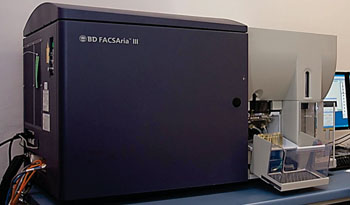Lung Eosinophils Play Protective and Beneficial Role
By LabMedica International staff writers
Posted on 08 Sep 2016
During allergic reactions such as asthma, the immune system does not work correctly and responds in an abnormal way to harmless allergens present in the environment such as pollen and dust mites.Posted on 08 Sep 2016
In an asthmatic individual, the eosinophil cells which are a type of granulocytes that are produced in the bone marrow and which circulate in the body via the blood and are recruited to the lungs where they participate to the pathological manifestations associated with an asthmatic reaction.

Image: The BD FACSAria III fluorescent cell sorter (Photo courtesy of BD).
An international team of scientists led by those at the University of Liege (Belgium) identified the existence of a sub-group of eosinophils called resident eosinophils which are present in the lungs of healthy individuals and which, unlike inflammatory eosinophils, play a regulatory and protective role while maintaining the balance of the immune system and preventing it from responding in an abnormal way such as observed during an asthma attack. The discovery of these specific eosinophils offers promising therapeutic and prophylactic opportunities for the treatment and prevention of asthma.
The team discovered this sub-type of eosinophil in mice and subsequently in humans. In mice, the nucleus of these resident eosinophils appears as a ring shape or doughnut shape, which makes them easily distinguishable from the other inflammatory eosinophils. In humans, all eosinophils have the same morphology, which could explain why the sub-types have only just been discovered. The scientists have also demonstrated, in both mice and humans, that the resident eosinophils carry an identical marker on their surface, the protein L-selectin or CD62L, which means that they are easily distinguishable from inflammatory eosinophils. Cell phenotyping and cell sorting were performed on a FACSAria III (BD Biosciences, San Jose, CA, USA).
Fabrice Bureau, DVM, PhD, a professor and senior author of the study said, “In the future, the question is to know how to facilitate the production of resident eosinophils, rather than inflammatory eosinophils, in the bone marrow. Indeed, by acting at the top of the cascade, we will have new weapons for the prevention of inflammatory diseases such as allergies or autoimmune diseases.” The study was published on August 22, 2016, in The Journal of Clinical Investigation.
Related Links:
University of Liege
BD Biosciences














